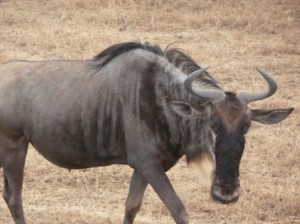
"Wildebeest" means "wild beast" in Dutch.
Have you ever felt restless? You don't know why, but you just NEED to MOVE. Watching the wildebeests, I wondered if that's how they felt as well. The story of the wildebeest is a story about moving – a lot of moving. Moving in circles – big circles, clockwise circles – defines its entire life. The scientists call it migration.

"Wildebeest" means "wild beast" in Dutch.
The wildebeest is a weird and wonderful looking animal. Its body is similar to a cow, but its an antelope. Its head looks like an ox, but it has horns like a buffalo. It has a mane and tail like a horse, a beard like a goat, and hooves like its antelope cousins!
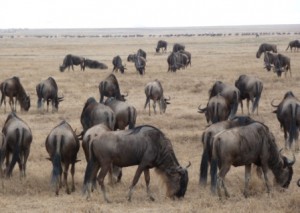
The plural of "wildebeest" is "wildebeest" or "wildebeests".
Being herbivores, wildebeests spend day and night grazing on the grasses covering the Serengeti and surrounding area. The Serengeti is a plain, and is one of the protected areas for the wild animals in Tanzania. The government set aside this land so people could no longer kill the animals or destroy their habitat. The Serengeti, Ngorongoro, Tarangire and others, are all very large and were created around the land where the most animals lived. However, there are no fences, and animals wander in and out of the protected areas. We visited all of these national parks and saw wildebeests and other animals in all of them.

The plural of "wildebeest" is "wildebeest" or "wildebeests".
The government needed to include a VERY large area to protect the wildebeest. The Serengeti National Park is 5700 square miles. Over a million wildebeests walk and run, in a clockwise direction, about 600 miles each year. When you consider that it's about a 1/2 mile from Cottage Lane School to Louie's Ice Cream shop, you realize that the wildebeests go a very long way!
Why do they do it? Survival. That may seem strange since thousands of wildebeests die along the way, but even more would die if they didn't move. They eat A LOT of grass. As they run out, they have to move on to find more grass. The weather determines when and where they move. The rains bring new grass, so they follow the rains.
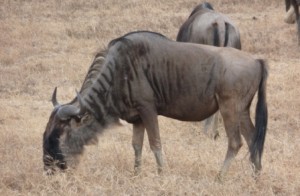
Wildebeests eat grass and leave behind fertilizer for more grass to grow.
As they move, they leave behind their poop, which acts as a good fertilizer for the grass. The wildebeests need the grass to eat. The grass needs the wildebeests for the fertilizer. They're interdependent.

Wildebeests eat grass and leave behind fertilizer for more grass to grow.
Sometimes wildebeests walk and sometimes they run. Often they travel in a single file line. There is no one leader, as in the elephant herds. Any wildebeest could start running and the whole herd will follow.
Since the wildebeest is an antelope it has hooves for feet. These hooves have a scent gland. Just like the elephants have a hole near their ear where smelly liquid comes out, wildebeests have a hole in their hooves. The smelly liquid is left along the path so other wildebeest herds know another herd has passed that way.
They like to stay together. It's safer that way. The wild dogs and hyenas, as well as the large cats in the area – lions, leopards, cheetahs – are always on the lookout for a wildebeest that has become separated from the herd.

We saw many crocodiles in the Mara River.
There's another deadly predator the wildebeests must face during their migration – the crocodile. To follow their migratory pattern, the wildebeests must cross the Mara River in northern Tanzania. It's filled with hungry crocodiles. Maybe some of you remember the scene in The Lion King. It was very scary.

We saw many crocodiles in the Mara River.
The day we were at the Mara River, a herd of a few hundred wildebeests was at the edge. They seemed to be thinking about how and when to cross. They looked….they grazed….they walked back and forth along the bank of the river.

A crocodile suns itself on the rocks while it waits for lunch to arrive.
They could see the hippos in the water, but they would not bother the wildebeests. I'm not sure if they could see the crocodiles camouflaged among the rocks.

A crocodile suns itself on the rocks while it waits for lunch to arrive.
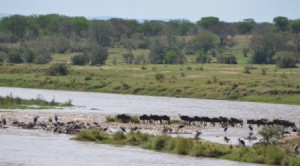
One wildebeest leads the others to river's edge. "Is it safe to cross here?"
After a few hours, the herd walked south along the river. One wildebeest then headed down the steep bank of the Mara. Others followed. They had found an area where the river wasn't so wide across. It might allow for a quicker crossing, but the water was flowing very rapidly here. The lead wildebeest carefully put its two front feet into the fast-flowing water and stopped. It made a decision. It turned around and headed back up the bank. This spot was too dangerous. The others followed.

One wildebeest leads the others to river's edge. "Is it safe to cross here?"
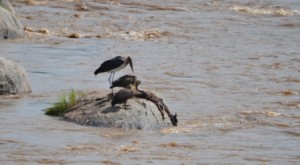
A stork and vulture pick at a wildebeest carcass that's a few days old.
By then it was late afternoon and we had to head back to camp. Perhaps they crossed later that day, or perhaps they waited until the next day. One thing's for sure- at some point their strong urge to keep moving would compel them to cross the river, no matter how dangerous.

A stork and vulture pick at a wildebeest carcass that's a few days old.
Because there are so many wildebeests that live on the Serengeti Plain, they have to migrate to survive. Other animals follow the wildebeests part, or all, of the way through their migration. Why? If the wildebeests became diseased and all died off, what do you think would happen to the ecosystem in this habitat? What do you think would happen to the habitat if the wildebeests stopped migrating?
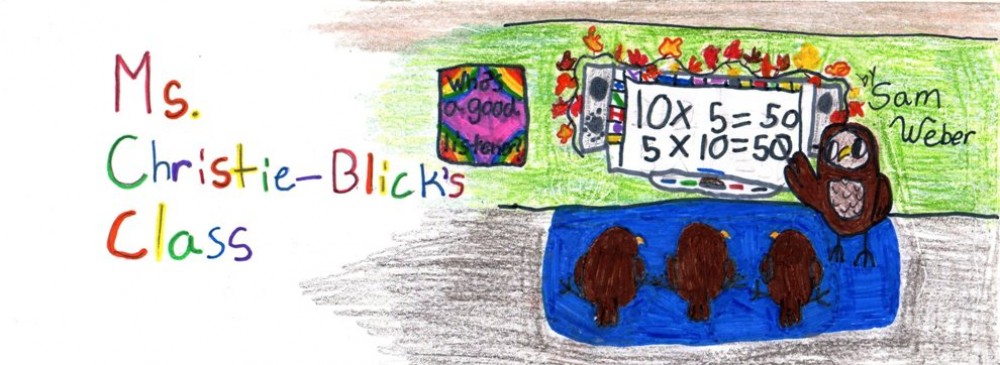
If the carcass was there then it could block the way of fish predetors to get them. They then would over populate and the animals that depend on fish will die.